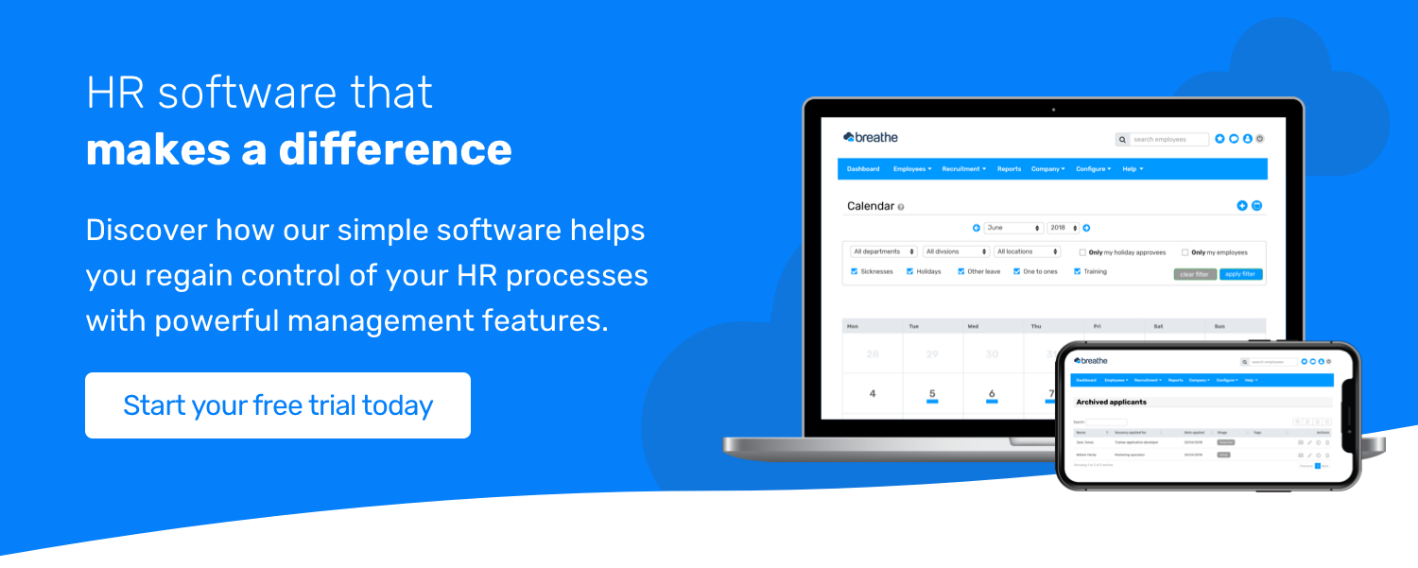Here’s a statistic that might shock you. Only 14% of employees agree that their performance reviews inspire them to improve.
It’s a sad state of affairs. Because if used effectively, performance reviews can supercharge employee engagement productivity and retention.
So what can you – as a manager or business owner – do to make the performance reviews in your organisation more effective?
Here are ten pieces of tried and tested advice to help you inject positivity into your performance review planning and keep your team motivated, empowered and engaged in their roles.
1. Allow enough time
Sometimes the simplest things make the biggest difference - show your employees you care about their development by booking in enough time for their performance review. Anything less than an hour can mean a rushed appraisal and an unhappy employee.
Allow time for discussion, reflection and the inevitable questions. If you’re hosting a performance review with a particularly talkative team member, then book in more time.
It’s good practice to err on the side of caution and book in more time than you think you’ll need – that way you have a buffer should the conversation take an unexpected route.
2. Prepare, prepare and prepare some more
Time spent preparing for a performance review is time well spent. As well as reviewing feedback and performance against results, spend time thinking about how your employee may react to some of the feedback and recommendations.
Brainstorm questions they may have for you and consider role-playing potentially awkward conversations with a trusted mentor.
Not sure what sort of thing to include in a performance review? Here are some prompts. Is your employee punctual? How do they work within the team? Do they suggest ideas for projects or objectives and show autonomy? Consider how well they meet deadlines and manage their workload, as well as how creative/innovative they are in their approach to the job. Don’t forget to mention any other project work they might do across the wider company.
3. Do your best to avoid surprises
A performance review works best when your employee knows what’s coming. This way, instead of feeling anxious, your employee can instead look forward to an open and helpful conversation about their development.
And the really good news? You’re probably already doing the work. By sharing feedback in weekly 121s or after relevant situations, you’re letting your employee know how they’re performing.
As well as being motivating in the case of positive feedback, ongoing feedback can help employees course-correct, improving their performance over the longer term.
4. Use employee self-assessment to make your job easier
Self-assessment can be your greatest ally in an effective performance review. Ask your employee to complete a self-assessment before the review. You can then use it as the basis of your meeting, leading with their perception of their performance and behaviour.
This approach challenges your employee to look at their performance honestly and instils a sense of responsibility and accountability. It can also reduce the chance of uncomfortable conversations – most people are harder on themselves than others are.
If there’s an objective that your employee hasn’t delivered against, leading with a self-assessment means they’ll mention their under-delivery before you do, making your job easier.
5. Use a wide range of feedback for a more effective performance review
Performance reviews mean more when they include feedback from a range of individuals. 360-degree feedback can help create a more rounded and personalised review with feedback on areas they weren’t aware of.
Read this post to learn more about 360-degree feedback.
6. Incorporate real life examples into your performance reviews
Want your staff to really value their performance reviews? Then be sure to collect feedback for the entire period. Take time throughout the year to document positive and negative events.
This gives you a full picture of an employee’s performance across the year and helps prevent recent events dominating the appraisal. This in turn makes the review more meaningful and helpful – you can see how your employee has developed over time and include examples that cover a range of skills.
Gathering examples throughout the year doesn’t need to be an extra task. If you’re holding regular one-to-ones then you’re already doing the work.
Keep track of your one-to-one meetings with HR software and you’ll have a helpful source to use when it comes to compiling a formal performance review.
7. Focus on the positive when doing a performance review
Structure your employee’s performance review so that you spend more time on positive aspects than negative. This approach feels more motivating and will help your employee feel appreciated.
It also allows you to add developmental feedback into the review as a next step, instead of as a criticism.
Here’s an example. You may have an employee who can come across as rude when he’s interrupted. Instead of telling him outright that people think he’s rude, you could praise his dedication to completing tasks and give him a next step which focuses on dealing with interruptions more positively.
 (1).webp?width=792&name=Breathe%20performance%20management%20user%20interface%20(1)%20(1).webp)
8. Use a direct approach to increase the effectiveness of your performance reviews
Successful performance reviews are focused conversations. Beware of the ‘feedback sandwich’- compliments, perhaps a bit of criticism, followed by more niceties. This format feels too formulaic. Instead, ask your employee to speak directly about their performance and use examples. Use questions such as:
- What do you expect to be the most challenging goals this quarter?
- What support do you require?
- How can I be a better manager?
- How often would you like feedback?
9. Be honest (and kind)
Make your comments as fair as you can - and be honest, whilst considering how any comments might be interpreted. Use examples of your employee’s work or behaviour over the period in review to back up what you’re saying.
Whilst honesty is always the best policy, bear your employee’s feelings in mind and maintain a high level of professionalism in your feedback.
10 . Put yourself in their shoes
Remember everyone responds differently to negative or unexpected feedback. Negativity bias means many people struggle to overcome negative events and comments. This means that performance reviews can unleash a number of emotions including panic and denial.
Be mindful of the potential for this and have strategies in place for keeping the focus on the review rather than the resulting emotions.
What should you do after a performance review?
Every good performance review has a clear set of next steps. Aim for an action plan, development plan and if necessary, new objectives, all with clear timescales which are documented and easily accessible to both parties.
Bear in mind that these next steps don’t need to be created in the performance review meeting itself. Your employee may need time to process the information you’ve shared with them.
Agreeing a follow-up meeting for development actions and new objectives can be a more practical – and less exhausting - alternative to squeezing everything into a single two-hour session.
Find out how Breathe can help simplify the performance management process for your business with employee performance and people management software.

Author: Laura Sands
Laura is a writer who enjoys getting into the detail of subjects and sharing that knowledge with snappy, interesting content. When not typing away, she enjoys walks in the woods and curling up with a good book and mug of something hot.




